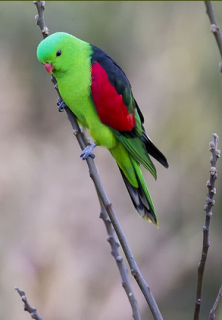Red-winged Parrot |
|
|
Also known as: Crimson-winged Parrot, Red-winged or Crimson-winged Lory, Blood-winged Parrot, King Parrot, Red-wing, Crimson-wing
Photos
View in GalleryDid You Know?
The colourful adult plumage of this bird is acquired at about 2-3 years of age, or the second complete moult.Academic Research
Related publications: Aprosmictus erythropterusSpecies Profile
Genus: Aprosmictus | Species: erythropterus
Size:
35cm (13.6 in)
Weight:
120-210g (4.2-7.35 oz)
Subspecies including nominate:
two: A.e. erythropterus, A.e. coccineopterus
Colour Adult:
A.e. erythropterus: Male-body colour bright green, with blue tint on hindcrown and occiput; black mantle, upper back and scapulars; deep blue on lower back, turning to paler blue on rump; bright red lesser, median and inner secondary wing coverts; black outer secondary coverts tipped with green; green tail tipped with yellow. Bill orange/red tipped with paler orange/red. Eye orange/red. Female-plumage duller: body green; green mantle, upper back and scapulars; blue lower back and rump; red outer, median and inner secondary wing coverts; black outer secondary coverts tipped with green; side tail feathers margined with red/pink on inner webs. Bill dull orange tipped with brown. Eye brown/orange.
A.e. coccineopterus: Male-differs from erythropterus in that there is stronger suffusion of blue on hindcrown and occiput; slightly paler red of upper wing coverts; slightly smaller in size. Female-as in erythropterus, but dull green of wings and upper back more yellow. Slightly smaller in size.
Colour Juvenile:
A.e. erythropterus: As in adult female, but in males black bases to secondaries form band at bottom edge of upper wing coverts, and yellow/green margins to secondary coverts give scalloped appearance. Bill orange/yellow. Eye pale brown.
Call:
Calls given in flight or soon after landing are sharp notes; when alarmed a repetitious, harsh chikking noise. While feeding emits soft, melodious chattering.
Listen NowVideo Links:
Video 1 | Video 2More Information:
Content Sources:
CITES
BirdLife International
Cornell Lab of Ornithology/Birds of the World
Parrots: A Guide to Parrots of the World, Juniper and Parr, 1998
ML Media Collection Catalogue 189000, Red-winged Parrot (Aprosmictus erythropterus), Mathers-Winn, Cedar A., Queensland, Australia, Nov. 8 2013, Cornell Lab of Ornithology. Site
Parrots of the World, Forshaw and Cooper, 1977. 2010 edition
Parrots of the World, Forshaw, 2006.
Lexicon of Parrots, Thomas Arndt.
Parrots in Aviculture, Low, 1992.
Parrots: Their Care and Breeding, Low, 1986.
Photos
View in GalleryDid You Know?
The colourful adult plumage of this bird is acquired at about 2-3 years of age, or the second complete moult.Academic Research
Related publications: Aprosmictus erythropterusSpecies Care
Captive Status:
Fairly common in Australia, less so elsewhere.
Longevity:
30-50 yrs
Housing:
Walk-in enclosure, minimum length 3m (9.8 ft).
Diet:
Small seed mix such as: canary, oats, safflower and a little hemp; spray millet; limited sunflower seed, dry, soaked or sprouted; sprouted beans such as mung, cooked butterbeans and lentils; boiled maize; green leaves such as: Swiss chard, lettuce, sowthistle, dandelion, chickweed; vegetables such as: carrot, corn, celery, zucchini or other squash, green beans and peas in the pod; fruit such as: apple, orange, banana, pomegranate; nuts such as: hazelnuts (lightly cracked), pecans, and roasted peanuts; complete pellet.
Enrichment:
Provide as big an aviary as possible, with many perches and fresh branches for chewing; provide water bowls for bathing. This species is acrobatic so also supply swings, different sized perches and ladders for climbing.
Nest Box Size:
Nest log or deep vertical box with inside diameter of 11-12" (28-30.5cm).
Clutch Size:
3-6
Incubation Time:
21 days
Fledging Age:
5-6 weeks
Hatch Weight:
8g (0.3 oz)
Peak Weight:
Not recorded.
Weaning Weight:
Not recorded.
Photos
View in GalleryDid You Know?
The colourful adult plumage of this bird is acquired at about 2-3 years of age, or the second complete moult.Academic Research
Related publications: Aprosmictus erythropterusSpecies Wild Status
World Population:
Unknown, decreasing.
IUCN Red List Status:
Least Concern
CITES Listing:
Appendix II
Threat Summary:
This parrot is considered to be generally common, locally abundant, and possibly benefiting from forest clearing in parts of Australia. Is sometimes illegally persecuted due to crop depredations. International trade up to 1987 consisted of several hundred birds annually, but after 1987 began doubling with all birds coming from Indonesia.
Range:
A.e. erythropterus: NE Australia from inland N New South Wales and NE South Australia north through Queensland to Cape York Peninsula and Gulf of Carpentaria.
A.e. coccineopterus: N Australia, along with larger offshore islands, from Kimberley division of W Australia east to NW Queensland; also S New Guinea, from mouth of Digul River, SE Irian Jaya to mouth of Fly River, SE Papua New Guinea.
Habitat:
Found up to 600m (1968 ft) in subtropical and semi-arid Eucalypt and casuarina woodland, forest edge, riverine woodland, Acacia scrub, mangrove, farmland, cypress pine, Callitris sp. scrub and lowland savanna.
Wild Diet:
Feeds on eucalypts, acacias and hopbush (Dodonea), plus mistletoe Loranthus berries and Grevillea blossoms. Also fruits of Geijera parviflora, and seeds of Cochlospermum fraseri, Amyema preissii, Gahnia, Crotalaria and Schinus areira plus other seeds, nuts, fruits, blossoms, nectar and insects such as Spondyliaspis eucalypti lerps and curculionid larvae.
Ecology and Behaviour:
Is nomadic at edges of range, but considered to be resident elsewhere. Is usually seen in small groups of up to 15 individuals; the largest groups seen at the end of the breeding season when families gather at feeding areas. Conspicuous and common.
Clutch and Egg Size:
3-6 rounded eggs, 31.0 x 26.0mm (1.2 x 1 in).
Breeding Season:
August–February generally, but April–July in NE Australia. Nest is in hollow limb or tree.
Related Links:
Photos
View in GalleryDid You Know?
The colourful adult plumage of this bird is acquired at about 2-3 years of age, or the second complete moult.Academic Research
Related publications: Aprosmictus erythropterusMembers Only Resources
Please log-in now to find more research, resources and tools.
Not a Member?
Find more great information:
Gain exclusive access to 600+ pages of additional research, seminars and podcasts, specialists to ask your toughest questions, and dozens of other fun resources - when you become a WPT member.
Join Today >>

































